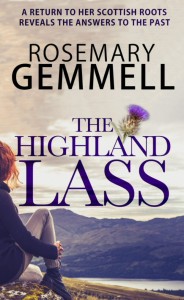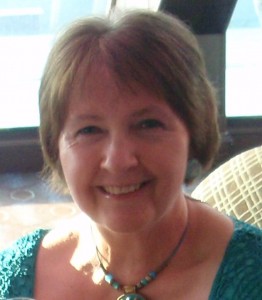 My latest full length novel, The Highland Lass, is the book of my heart as it means such a lot to me, both for its setting and its time-split storyline. For the first time, I set a novel almost completely around my own beautiful area of Scotland and that immediately gave it a deeper level of authenticity, rather than having to imagine the places where my characters interacted. Obviously, this was even easier for the contemporary story as I had walked in these areas myself. The short alternate historical chapters are set in the eighteenth century and it was surprisingly easy to imagine life in those times, especially in one particular area.
My latest full length novel, The Highland Lass, is the book of my heart as it means such a lot to me, both for its setting and its time-split storyline. For the first time, I set a novel almost completely around my own beautiful area of Scotland and that immediately gave it a deeper level of authenticity, rather than having to imagine the places where my characters interacted. Obviously, this was even easier for the contemporary story as I had walked in these areas myself. The short alternate historical chapters are set in the eighteenth century and it was surprisingly easy to imagine life in those times, especially in one particular area.
The Highland Lass was greatly inspired by the story of Robert Burns and his Highland Mary, which I had researched and written about in an article some years ago for The Highlander magazine in the USA. Most people know that Burns is our national bard here in Scotland and that he was a famous womaniser as well as a wonderful poet and writer of Auld Lang Syne. Highland Mary is buried in my home town and their story has fascinated me since childhood. Burns himself wrote about his Highland Lass in several poems with such an air of regret and guilt that I knew their ill-fated love story would make a good subject for a romance.
After writing the non-fiction article about them, my imagination was fired and I was eager to fictionalise Mary’s voice and write part of the story from her point of view. However, I didn’t think there were enough facts about them to sustain a book set completely in the 18th century. Since I love to read split-time stories, I decided to write a contemporary story about family secrets and a link to the past, through Eilidh Campbell, a possible ancestress of Highland Mary. Her love story with Lewis Grant is alternated with short historical chapters told in Highland Mary’s voice in the 18th century.
My picturesque area of the west coast of Scotland also provided much of the inspiration, especially with Highland Mary buried in the town cemetery, and she was born just across the River Clyde in Dunoon, Argyllshire which is partly in the highlands. The villages of Ayrshire (further south) where Mary met Burns, have hardly changed in many respects and I was even able to sit in the very inn, Poosie Nancie’s, where Burns and his friends used to drink in the 18th century. Another location used in the contemporary part of the novel is Loch Lomond which is only about half an hour from my home and which constantly inspires my romantic imagination. There are even a couple of scenes in Glasgow, my nearest vibrant city with its wonderful architecture and friendly people.
It has been a dream come true to see this story finally published in ebook and print and its popularity so far has made the wait worthwhile. Perhaps there’s something to be said for writing and publishing other books and stories before this one, as most writers improve with each book. Or perhaps it meant so much to me that I was reluctant to send this ‘baby’ out into the world for fear it wouldn’t be loved as much as I hoped. Fortunately, my fears have been unfounded (so far!) and The Highland Lass continues to be the book of my heart. I’ve also learned a valuable lesson: that setting can be as much a character as people at times.
Blurb
Eilidh Campbell returns to her Scottish roots from America with one main aim: to discover the identity of her real father. But her mother’s past in Inverclyde is a mystery with family secrets, a book of Robert Burns’ poems with a hidden letter and a photograph link to the Holy Loch at Dunoon when the American Navy were in residence.
Staying with her childhood friend, Kirsty, while searching for answers, Eilidh begins to fall in love with handsome Scot Lewis Grant, but just how free is he? Together they trace the story of Highland Mary and Robert Burns, with its echoes to her mother’s story. In short alternate chapters, Highland Mary tells her own story from 1785-6. From Dunoon, to Ayrshire and culminating in Greenock, Eilidh finds the past is closer than she realises.
Excerpt from one of the historical chapters
“And are you well, sir?” I cannot ask right out about Jean Armour but I hope he might give some sign of having put her from mind.
“Well enough, thank you, especially for having seen your lovely face again.”
So he is not pining after Jean too much, or he is hiding it well. Or perhaps he cannot help being of a flirtatious nature, since he’s so admired by many. I should think him vain except for the fact he writes such far-seeing words, if what I hear is true.
I smile at his flattery and do not reply. I’d rather find out more about his poetry.
“And you still write such good verse, I hope, sir?” I cannot bring myself to call him by his name.
He stops at that and looks at me strangely, as though surprised I should talk of it. “All the time, when work allows, Mary. I have hopes of having a collection published one day. It’s hard work keeping the farm going and it’s something to dream of. And what are your dreams, if I may ask, Mary Campbell?”
I shrug, for truly I have not thought of many things. “To be happy and to be loved, I think.”
He laughs. “The one does not necessarily go with the other.” His words sound slightly bitter. Or perhaps I imagine that he speaks of Jean Armour.
Then he looks me full in the eyes. “But I should not think you’ll have trouble in being loved.”
I do not realise we are so close as we walk, but now his nearness makes the fine hairs on my arms stand on end. And before I can answer or guess at his intentions, he reaches over and kisses my parted lips.
My reaction is swift. I step back in confusion.
“Forgive me, Mistress Campbell, but you look so sweet with your concerned blue eyes. I forget myself.”
My heart has returned to its normal beat, but I cannot look at him. His kiss will linger in my mind far longer than the quick touch on my lips. But I don’t want his teasing, or his dalliance with a willing maid, or even his attempts at banishing another from his mind. The only way I will allow myself to be his, is if he is ever fully mine. And that day has not yet come, if ever it might.
“I must go now, sir,” I say, without looking at him. I walk away, my body on fire.
Author Bio
Rosemary Gemmell lives in the beautiful west coast of Scotland and is a published historical and contemporary novelist for adults (as Romy) and writes for the Middle Grade age group as Ros. The Highland Lass is the first novel under her full name. Her short stories, articles and occasional poems have been published in UK magazines, in the US, and online. She has a Post-graduate Masters in literature and history and is a member of the Society of Authors, the Romantic Novelists’ Association, and the Scottish Associations of Writers. She loves to dance!
Links
Amazon US: http://www.amazon.com/dp/B00TOTER6Q
Amazon UK: http://www.amazon.co.uk/dp/B00TOTER6Q
Website: http://www.rosemarygemmell.com
Blog: http://ros-readingandwriting.blogspot.com
Twitter: https://twitter.com/RosemaryGemmell
Facebook (as Romy Gemmell): https://www.facebook.com/pages/Romy-Gemmell/1422387704702586
Pinterest: http://www.pinterest.com/rosgemmell/
Trailer: http://youtu.be/YPo8Tk-xlXE

